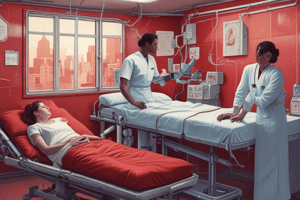Podcast
Questions and Answers
What is the significance of 1939 in the context of blood groups?
What is the significance of 1939 in the context of blood groups?
- Discovery of the Hemolytic Disease of the Newborn
- Discovery of the ABO blood group
- Establishment of the first hematology laboratory
- Discovery of the Rhesus blood group (correct)
What is one of the functions of the hematology laboratory?
What is one of the functions of the hematology laboratory?
- To perform surgeries
- To conduct clinical trials
- To develop new medications
- To establish a diagnosis or rule out a diagnosis (correct)
Why is it important to study hematology and blood transfusion?
Why is it important to study hematology and blood transfusion?
- To develop new medical equipment
- To make appropriate diagnoses and prepare safe blood products for transfusion (correct)
- To improve hospital management
- To conduct research on infectious diseases
What is one of the potential hazards in a hematology laboratory?
What is one of the potential hazards in a hematology laboratory?
What is essential for preventing accidents and laboratory-acquired infections?
What is essential for preventing accidents and laboratory-acquired infections?
What is one of the key safe practices in a hematology laboratory?
What is one of the key safe practices in a hematology laboratory?
What is one of the hazards in a hematology laboratory environment?
What is one of the hazards in a hematology laboratory environment?
Why is safety important in a hematology laboratory?
Why is safety important in a hematology laboratory?
What is one of the viruses that hematology laboratory workers should be concerned about?
What is one of the viruses that hematology laboratory workers should be concerned about?
What is prohibited in the laboratory work area?
What is prohibited in the laboratory work area?
Why should food and drinks not be kept in the same refrigerator as laboratory specimens or reagents?
Why should food and drinks not be kept in the same refrigerator as laboratory specimens or reagents?
What should be done with contaminated sharps?
What should be done with contaminated sharps?
Why should certain laboratory procedures be performed behind a barrier or with protective eyewear?
Why should certain laboratory procedures be performed behind a barrier or with protective eyewear?
What should laboratory workers wear when handling potentially infectious materials?
What should laboratory workers wear when handling potentially infectious materials?
What is a reason for prohibiting mouth pipetting?
What is a reason for prohibiting mouth pipetting?
Why should needles and other sharp objects contaminated with blood and other potentially infectious materials not be manipulated?
Why should needles and other sharp objects contaminated with blood and other potentially infectious materials not be manipulated?
How long is a 1:10 solution of bleach effective for?
How long is a 1:10 solution of bleach effective for?
What should be done with paper towels used in the decontamination process?
What should be done with paper towels used in the decontamination process?
What should be included on the label of a 1:10 solution of bleach?
What should be included on the label of a 1:10 solution of bleach?
Why are phenol-based disinfectants used?
Why are phenol-based disinfectants used?
What is required after each shift in the laboratory?
What is required after each shift in the laboratory?
What should be done with non-disposable laboratory coats?
What should be done with non-disposable laboratory coats?
What should an employee do if they refuse the HBV vaccination series?
What should an employee do if they refuse the HBV vaccination series?
What should employees be encouraged to do regarding exposure incidents?
What should employees be encouraged to do regarding exposure incidents?
What is the normal range of RBC in men?
What is the normal range of RBC in men?
What is the primary function of Neutrophils?
What is the primary function of Neutrophils?
What is the normal range of WBC in a healthy individual?
What is the normal range of WBC in a healthy individual?
What is the primary function of Lymphocytes?
What is the primary function of Lymphocytes?
What is the term for low Neutrophil count?
What is the term for low Neutrophil count?
What is the term for high RBC count?
What is the term for high RBC count?
When should all work surfaces be cleaned?
When should all work surfaces be cleaned?
What is a common cause of contamination on work surfaces?
What is a common cause of contamination on work surfaces?
What is the recommended dilution of household bleach for disinfectant solution?
What is the recommended dilution of household bleach for disinfectant solution?
How often should the disinfectant solution be made fresh?
How often should the disinfectant solution be made fresh?
What information should be labeled on the container of disinfectant solution?
What information should be labeled on the container of disinfectant solution?
What surfaces should not be cleaned with bleach?
What surfaces should not be cleaned with bleach?
What should be done with paper towels used in the decontamination process?
What should be done with paper towels used in the decontamination process?
What is required after each shift?
What is required after each shift?
Flashcards are hidden until you start studying
Study Notes
Haematology and Blood Transfusion
- 1939: Rhesus blood group was discovered, leading to the understanding of Haemolytic Disease of the Newborn (HDN)
- Other blood group systems are now known, highlighting the importance of studying Haematology and Blood Transfusion
Functions of the Haematology Laboratory
- Establish a diagnosis or rule out a diagnosis
- Confirm a physician's clinical impression of a possible hematological disorder
- Detect an unsuspected disorder
- Monitor the effects of therapy
- Detect minimal residual disease following therapy
- Perform functions like making a diagnosis, carrying out research, preparing safe blood products, and reporting laboratory results accurately
Safety in Haematology Laboratory
- Many conditions in the laboratory have the potential for causing injury to staff and damage to the building or community
- Managers and employees must be knowledgeable about safe work practices and incorporate these into the laboratory operation
- The key to preventing accidents and laboratory-acquired infections is a well-defined safety program
Biohazards and Chemical Hazards
- Biohazards include hepatitis B virus (HBV), hepatitis C virus, and human immunodeficiency virus (HIV)
- Chemical hazards must be handled with care to prevent accidents
Applicable Safety Practices Required by the OSHA Standard
- Handwashing is essential
- Eating, drinking, smoking, and applying cosmetics or lip balm are prohibited in the laboratory work area
- Hands, pens, and other fomites must be kept away from the worker's mouth and all mucous membranes
- Food and drink must not be kept in the same refrigerator as laboratory specimens or reagents
- Mouth pipetting is prohibited
- Needles and other sharp objects contaminated with blood and other potentially infectious materials must be handled with care
- Contaminated sharps must be placed in a puncture-resistant container with the universal biohazard symbol
- Procedures that may produce splashing, spraying, or droplets must be performed behind a barrier or with protective eyewear
Housekeeping and Disinfection
- Work surfaces must be cleaned when procedures are completed and whenever the bench area or floor becomes visibly contaminated
- An appropriate disinfectant solution is household bleach in a 1:10 volume/volume dilution (10%)
- Bleach solution must be made fresh daily and labeled properly
- Other solutions used to decontaminate include phenol-based disinfectants, tuberculocidal disinfectants, and 70% ethanol
- Documentation of the disinfection of work areas and equipment after each shift is required
Laundry and Personal Protective Equipment
- Non-disposable laboratory coats must be placed in appropriate containers for transport to the laundry
- Laboratory workers should receive the HBV vaccination series at no cost before or within 10 days after beginning work in the laboratory
Hepatitis B Virus Vaccination and Post-Exposure Evaluation
- Employees must sign a release form if they refuse the vaccination series
- Post-exposure evaluation and follow-up, including prophylaxis and medical consultation, should be made available at no cost to the employee
Training and Documentation
- Hematology staff should be properly educated in epidemiology and symptoms of bloodborne diseases, modes of transmission, use of protective equipment, and work practices
- Employees should be encouraged to report all exposure incidents, and such reporting should be enforced as standard policy
Blood Cell Counts and Their Clinical Applications
- RBC: Men: 4.5 – 5.5 x 10^12/L, Women: 3.8 – 4.8 x 10^12/L
- WBC-Total: 4.0 – 10.0 x 10^9/L
- WBC-Differential: Neutrophils: 2.0 – 7.0 x 10^9/L (40 – 80%), Lymphocytes: 1.0 – 3.0 x 10^9/L (20 – 40%)
- Blood cell counts have clinical applications in diseases such as Erythrocytosis, Leucopenia, Leucocytosis, Neutropenia, and Lymphocytosis
Studying That Suits You
Use AI to generate personalized quizzes and flashcards to suit your learning preferences.




